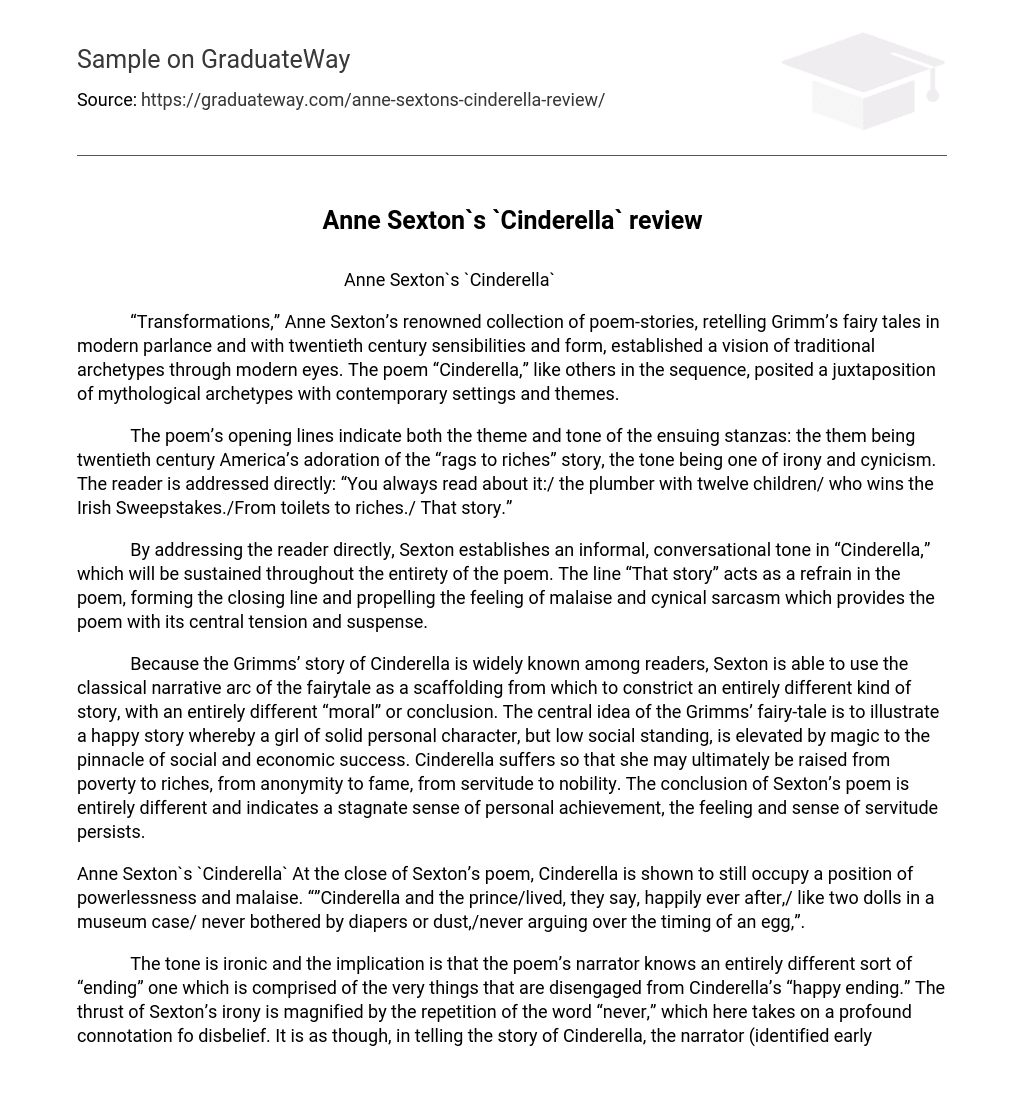“Transformations,” Anne Sexton’s renowned collection of poem-stories, retelling Grimm’s fairy tales in modern parlance and with twentieth century sensibilities and form, established a vision of traditional archetypes through modern eyes. The poem “Cinderella,” like others in the sequence, posited a juxtaposition of mythological archetypes with contemporary settings and themes.
The poem’s opening lines indicate both the theme and tone of the ensuing stanzas: the them being twentieth century America’s adoration of the “rags to riches” story, the tone being one of irony and cynicism. The reader is addressed directly: “You always read about it:/ the plumber with twelve children/ who wins the Irish Sweepstakes./From toilets to riches./ That story.”
By addressing the reader directly, Sexton establishes an informal, conversational tone in “Cinderella,” which will be sustained throughout the entirety of the poem. The line “That story” acts as a refrain in the poem, forming the closing line and propelling the feeling of malaise and cynical sarcasm which provides the poem with its central tension and suspense.
Because the Grimms’ story of Cinderella is widely known among readers, Sexton is able to use the classical narrative arc of the fairytale as a scaffolding from which to constrict an entirely different kind of story, with an entirely different “moral” or conclusion. The central idea of the Grimms’ fairy-tale is to illustrate a happy story whereby a girl of solid personal character, but low social standing, is elevated by magic to the pinnacle of social and economic success. Cinderella suffers so that she may ultimately be raised from poverty to riches, from anonymity to fame, from servitude to nobility. The conclusion of Sexton’s poem is entirely different and indicates a stagnate sense of personal achievement, the feeling and sense of servitude persists.
Anne Sexton`s `Cinderella` At the close of Sexton’s poem, Cinderella is shown to still occupy a position of powerlessness and malaise. “”Cinderella and the prince/lived, they say, happily ever after,/ like two dolls in a museum case/ never bothered by diapers or dust,/never arguing over the timing of an egg,”.
The tone is ironic and the implication is that the poem’s narrator knows an entirely different sort of “ending” one which is comprised of the very things that are disengaged from Cinderella’s “happy ending.” The thrust of Sexton’s irony is magnified by the repetition of the word “never,” which here takes on a profound connotation fo disbelief. It is as though, in telling the story of Cinderella, the narrator (identified early on in the Transformations sequence as a “middle aged witch”) has concluded that the “rags to riches” fable is merely a complex series of lies and half-truths.
The poem’s deeper realities, merged with the fairytale myths, result in lines such as “never bothered by diapers or dust,” which ironically juxtapose real-life details and drudgeries against the magnificent facade of the Cinderella myth of unspoiled and persisting happiness. Other lines such as “never telling the same story twice,/ never getting a middle-aged spread” elaborate on the merging of the real and fairy worlds.
The imagery of Sexton’s concluding stanza in “Cinderella” also foists a feeling of profound irony and sarcasm. Against the fairytale vision of castles and white horses and crowns and long gowns, Sexton imagines Cinderella and her Prince “like two dolls in a museum case” showing that happiness or perfection can only be projected onto the still, the lifeless, or the dead. Furthermore,
Anne Sexton`s `Cinderella` the Prince and Cinderella are imagined as resting side by side “their darling smiles pasted on for an eternity./ Regular Bobbsey Twins.” With these lines, spotlighting contemporary references, Sexton hurls and indictment at her audience and at her peers, establishing the hitherto debunked “myth” of Cinderella as the persistent belief of society rather than the “truthful” vision offered by her story-poem.
Sextons’ observation that the happy Prince and Cinderella live together “never telling the same story twice,” furthers the aforementioned criticism of contemporary myths and beliefs; in effect, positing the “Cinderella” myth as one which will continue on because it is useful for those who wish to divert the masses and popular imagination away from truth, the truths ironically indicated by the tone and specific images of Sexton’s poem.
A key phrase in the poem’s concluding stanza is “they say” which exposes the “Cinderella” myth as a lie, as propaganda. The tone of the concluding stanza is one of abiding irony and sarcasm, with the implication that the poem’s narrator has seem through the fairytale to the truth and now understands that the terrible truth of contemporary marriage and love and sex is in many ways the result of the fallacious belief in fairytales, In fact, the whole process is shown to have a cyclical, circular continuance, with the fairytale in effect breeding discontent with its pie-in-the=sky promises of an unattainable happiness.
This cyclical nature, the circular perpetuation of harmful, stifling myth is represented by the poem’s concluding line, which as mentioned earlier provides a refrain for Sextons’ “Cinderella” poem: “That story.” The ending of the poem places the Cinderella myth firmly, and at long last, where Sexton believes it belongs. It is a story and therefore not truth. The final ironic implication is that Sexton’s story, the narrator’s story, do offer truth, one which can only be understood through a comprehensive deconstruction and abolishment of the original fairytale from which both the lived experience which provides the thematic impetus of the poem, and the prosodic and archetypal components of Sexton’s poem are constructed.
Using X.J. Kennedy`s definition of `tone` in the file uploaded, discuss the tone of the final stanza of Anne Sexton`s `Cinderella.` What does it suggest about the way fairy tales usually end, and how does the tone help to convey this? This requires connecting it with the theme of the whole poem. Remember that the details Sexton uses in her version are in the original Grimm tale.





